This guide initially displays all weeds in the Los Alamos area classified in NM as noxious regardless of shape. Use the selectors below to include nonclassified weeds or select a specific set, either by shape or name.
The term weed is commonly used to denote a plant that is growing in an area where it is not valued. It is officially defined by the USDA Animal and Plant Health Inspection Service as being any plant that poses a threat to agriculture and/or a natural ecosystem. A noxious weed is one that is particularly troublesome and can directly or indirectly injure or cause damage to crops, livestock, or natural resources.
In general, plants that are within their native range live in balance with their environment and are not typically considered to be weeds. Issues can occur, however, if a plant is introduced, either directly or indirectly, to a new ecosystem. These, now non-native plants, may be able to thrive in their new environment. If so, these naturalized plants can fall into one or two categories long term: (1) plants that are valued for their flowers and fruit and (2) plants that are rapidly considered to be weeds. The plants in the latter category are those that are generally regarded as noxious weeds.
While some species shown here are included in the PEEC Flower and Tree Guides, this guide concentrates on some of the nastier introduced species that you might see in your yard or on local trails. In addition, this guide includes some native plants that meet the general definition of weed.
Weed References
A Plan For the Control of Invasive Species on Los Alamos County Open Space — Craig Martin [PDF]
Los Alamos Master Garden Weed List
NMSU Weed Information
SEINet: Southwest Biodiversity
Some Common Lawn and Garden Weeds of Los Alamos, NM — Dorothy Hoard and Teralene Foxx [PDF]
Troublesome Weeds of NM
USDA: Introduced, Invasive, and Noxious Plants
Weed Alert
Weeds of the Los Alamos Area — Teralene Foxx [PDF]
Subject Area Experts (all guides)
Steve Cary (butterflies)
Beth Cortright (insects)
Terry Foxx (invasive plants)
Leslie Hansen (mammals)
Richard Hansen (fish, mammals)
Dorothy Hoard (butterflies, trees)
Chick Keller (flowers, herbarium)
Shari Kelley (geology)
Kirt Kempter (geology)
Garth Tietjen (reptiles)
David Yeamans (birds)
Web Development and Content Management
Pat Bacha
Jennifer Macke
Graham Mark
Akkana Peck
Contact
Please contact us for local nature questions and sightings. We welcome comments, corrections, and additions to our guides.
For more information about local nature, please visit our Nature Blog or subscribe to PEEC This Week.
Make Selection
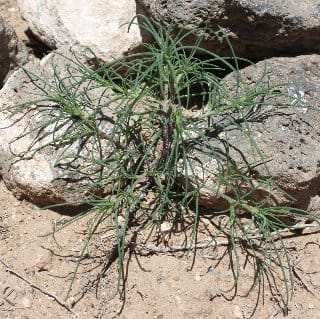 Photo: Akkana Peck 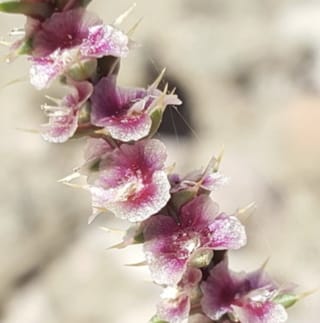 Photo: Alex Abair  Photo: Akkana Peck |  Russian Thistle, Prickly Russian Thistle, Russian-thistle, TumbleweedSATR12 (Salsola tragus)Family: Amaranthaceae (Amaranths) Size: up to 40 in (102 cm) Growth: forb/herb; annual Status: non-native; classified weed (common) Native Range: Africa, Asia, and Europe NM Noxious Weed Class: C - widespread Habitat: rangeland, croplands, roadsides, industrial areas, and along railroad right-of-ways Typical location: White Rock Control Notes: pull up just below ground level before seeds set; repeated mowing or tilling effective; control with leaf mining moth poor; several herbicides effective Salsola tragus arrived in North America in the late 1800’s. Since then it has become one of the most troublesome weed in the drier parts of the western states. It not only infects ranges, pastures and cropland but is the is the host for the beet leafhopper which is the vector for a virus infecting a number of food crops such as tomatoes, beans, and melons. Lastly, mature plants that die out, break off, and tumble away present a potential hazard as they blow across roads, startling motorists, and fill irrigation ditches, blocking water flow to crops. Russian Thistle is a bushy, spiny plant with upward-curving branches and stiff, prickly leaves. The plant looks bluish-green overall and has a deep taproot with spreading lateral roots capable of extracting moisture deep within the soil. The flowers are small and mostly solitary and located in the leaf axils. They are brownish to pinkish red. Seeds are dispersed by the tumbleweeds as they are tossed around by the wind. Young plants can be used as fodder and is palatable to a variety of wildlife species. It is a particular favorite of prairie dogs. Young shoots have even been cooked and eaten by humans. The seeds are consumed by several different birds and small mammals. Lastly, the plants have been used since antiquity to aid in the produce a concentrated solution of sodium carbonate that is added to other ingredients for making soap and glass. Info Photos Distribution |
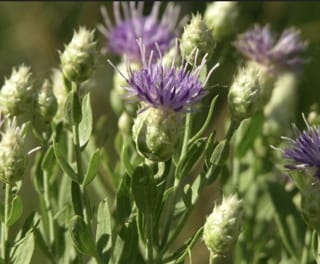 Photo: Jerry Oldenettel 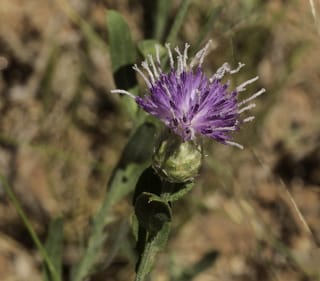 Photo: Craig Martin 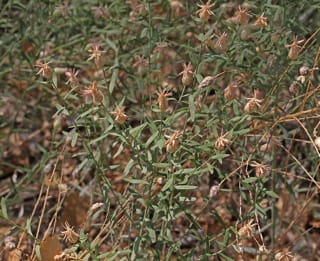 Photo: Jerry Oldenettel |  Russian Knapweed, Hardheads, Truestan ThistleACRE3 (Acroptilon repens, Rhaponticum repens)Family: Asteraceae (Daisies) Size: up to 36 in (91 cm) Growth: forb/herb; perennial Status: non-native; classified weed (common) Native Range: Eurasia NM Noxious Weed Class: B - limited distribution Habitat: disturbed areas, roadsides, pastures, waste places, and croplands Typical location: Anniversary Trail Control Notes: can resprout from root fragments so mechanical methods in general not highly effective, though repeated cutting/pulling can control but not eliminate an infestation; fire and biological controls not very effective; herbicides should be used as last resort and applied before seeds produced Russian Knapweed was accidentally introduced into North America in the early 1900’s as a seed contaminant. It spreads rapidly, crowding out other species and reducing the quality of crop (alfalfa, wheat, barley, and oats) and range lands. Though it is found throughout most of the US, the area west of the Rocky Mountains is the most highly infected. This species can cause chewing disease in horses. The stems of Russian Knapweed grow out from from a basal rosette of leaves. The leaves, themselves, are long and lobed at the bottom of the plant and become smaller and less lobed towards the top. The urn-shaped flowers are pink to purple and become straw-colored when mature. Fruits consist of white capsules with tufts of hair. The plant has deep roots and can live up to 75 years or more. Russian Knapweed is toxic to horses causing something known as chewing disease. However, most livestock avoid the plant due to its bitter taste. There have been some studies uses extracts of the plant as an insecticide. Info Photos Distribution |
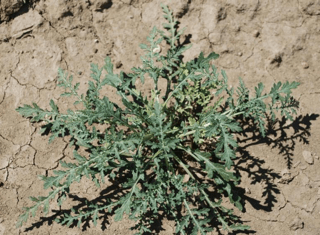 Photo: Howard F. Schwartz, Colorado State University, Bugwood.org 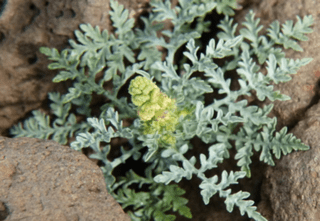 Photo: lunamothkd 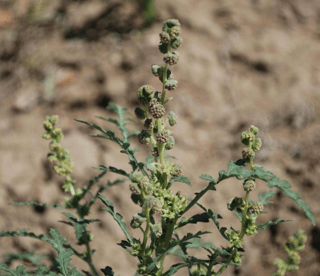 Photo: Howard F. Schwartz, Colorado State University, Bugwood.org |  Skeletonleaf Bur Ragweed, Skeletonleaf Bursage, BurragweedAMTO3 (Ambrosia tomentosa)Family: Asteraceae (Daisies) Size: up to 36 in (91 cm) Growth: forb/herb; perennial Status: native; classified weed (common) Native Range: west-central United States NM Noxious Weed Class: B - limited distribution Habitat: disturbed sites such cultivated fields, pastures, and waste areas Control Notes: mowing does not kill bursage but may delay seed production; number of herbicides are effective Despite being a native plant, Skeletonleaf Bur Ragweed is a particularly aggressive weed. It emerges earlier than crops in which it may be associated, thus outcompeting them for light, moisture, and nutrients. In addition, livestock find it unpalatable. The plant is considered to be unsightly while its pollen aggravates the allergies of those individuals with ragweed sensitivity Skeletonleaf Bur Ragweed has long, greenish-gray leaves that are deeply lobed with toothed edges. The lower leaf surface is white and covered with short, dense hairs. Each flower head contains either male or female flowers but not both. The flowers are rather inconspicuous and yellow in color and tend to droop. The fruits develop into light brown burs with numerous short spines. Skeletonleaf Bur Ragweed is long lived and its extensive root system makes eradication very difficult. It does not appear to have any reported know uses. Info Photos Distribution |
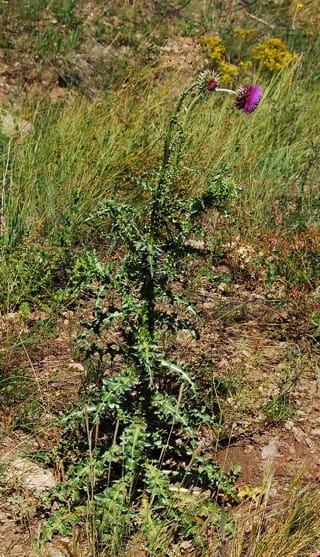 Photo: Jerry Oldenettel 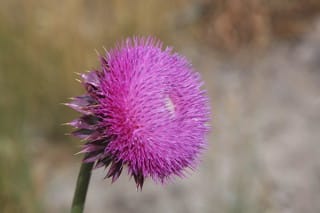 Photo: Mary Carol Williams 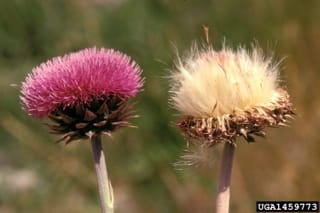 Photo: Steve Dewey, Utah State University, Bugwood.org |  Musk Thistle, Nodding Thistle, Nodding Plumeless ThistleCANU4 (Carduus nutans)Family: Asteraceae (Daisies) Size: up to 72 in (183 cm) Growth: forb/herb; biennial, perennial Status: non-native; classified weed (common) Native Range: Europe and Asia NM Noxious Weed Class: A - very limited distribution Habitat: grasslands, disturbed areas, and agricultural settings Control Notes: cut the plants down just as the flowers begin to open; dig up the plants and roots; musk thistle weevil can be introduced; lastly selective herbicides can be applied after the seedlings have emerged Musk Thistle was accidentally introduced in the US in the early 1900s. Once established in area, it spreads rapidly due to the fact that a single plant can produce up to 120,000 seeds. Also the plant is difficult to control since the seeds can remain viable in the soil for over ten years. It is relatively unpalatable to livestock so Musk Thistle is a particular problem in pastures. Carduus nuts is very tall and looks like it has stems and leaves that give it the appearance of spiny wings. The flower heads are red to purple and are made up of hundreds individual flowers. They are slowly, solitary, and hemispherical. The common name of Nodding Thistle is derived from the tendency of the flower heads to droop when mature. The seeds are straw-colored and have long bristles. The flowers are a good source of food for hummingbirds and bees. Some birds, including the goldfinch, will eat the seeds. The plant can be eaten if the stalk is peeled. Young leaves can be made into a drink. Lastly, a tonic made from the seeds and leaves can be used to stimulate liver function. Info Photos Distribution |
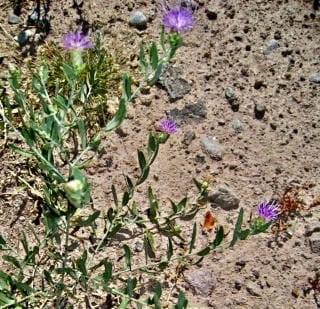 Photo: Jennifer Macke Photo: Jim Keesling 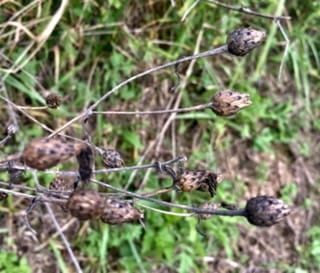 Photo: Theo Witsell |  Spotted KnapweedCESTM (Centaurea stoebe, Centaurea biebersteinii, Centaurea maculosa)Family: Asteraceae (Daisies) Size: up to 36 in (91 cm) Growth: forb/herb; biennial, perennial Status: non-native; classified weed (common) Native Range: Europe NM Noxious Weed Class: A - very limited distribution Habitat: along roadsides and railroads, pastures and abandoned fields, and vacant lots Control Notes: mechanical removal before seed dispersal must eliminate at least 3 to 4 in (7 to 10 cm) of root crown; herbicides are effective; fire is not Spotted Knapweed was most likely introduced into the US in the late 1800s through contaminated seed or ballast. The plant spreads aggressively, particularly in dryer regions, and crowds out both native species and forage plants. It is a nuisance and a potential hazard to animals and humans as the stems are stiff and scratchy. Once established areas of Spotted Knapweed can persist almost indefinitely. Once the plant matures and dries out, it breaks off at the base and then is blown around with the wind as a tumbleweed, dispersing seeds far and wide. Spotted Knapweed is a short-lived plant with ribbed stems and a woody texture. The leaves are lobed and grayish-green with small bristly hairs. The flower heads are thistle-like with ray florets that are pink to purple. Typically there are 25 to 100 flower heads per plant. The seed heads are brown, finely haired, and elliptical in shape. There is a short tuft of white hairs at the tip of each seed. Various long-tongued bees and butterflies will take nectar from the Spotted Knapweed. It is also possible that some small rodents and birds will eat the seeds. Mammalian herbivores tend to avoid the plant due to its bitter foliage. Info Photos Distribution |
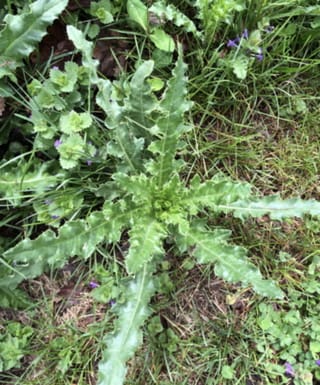 Photo: perzley 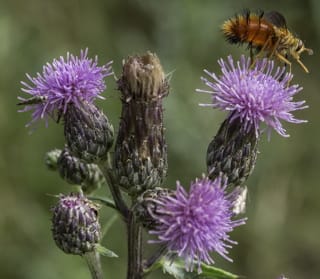 Photo: Craig Martin 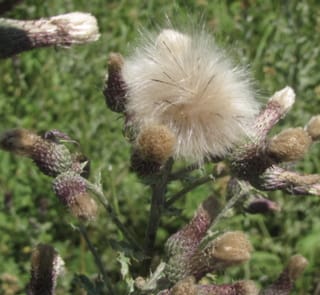 Photo: Chuck Sexton |  Canada Thistle, Creeping Thistle, Canadian ThistleCIAR4 (Cirsium arvense)Family: Asteraceae (Daisies) Size: up to 40 in (102 cm) Growth: forb/herb; perennial Status: non-native; classified weed (common) Native Range: Eurasia NM Noxious Weed Class: A - very limited distribution Habitat: dry to moist open areas including fields, grasslands, pastures, stream banks, and open forests Control Notes: late spring burns are effective but must be done 3 years in a row; pulling can stimulate the plants unless done repetitively; mowing needs to be done during the early bud stage Canada Thistle was accidentally introduced to North America in the 1600s and is now designated as a noxious weed in 43 states. Despite the common name it does not have a Canadian origin. The plant can form dense stands that displace native plants disrupting the plant community structure. Once established it is very difficult to remove. The plant has lance-shaped leaves with clusters of purple or pink flowers borne at the end of the stems. It produces numerous short seeds that are dispersed by wind. Canada Thistle can also spread by roots. It has an extensive underground structure with four types — (1) thick, horizontal roots, (2) long, vertical roots, (3), short, fine shoots, and (4) underground vertical stems. The plant is capable for forming extensive colonies from the numerous underground shoots and is often the first plant to invade a disturbed area. It thrives in moderate sunshine and temperatures with plentiful water. The plant is actually more nutritious than alfalfa but livestock avoid the plant because of its spines, though they will sometime eat the flowers. Sheep and goats will only eat the very young plants. However, it is very beneficial to pollinators that rely on nectar. Info Photos Distribution |
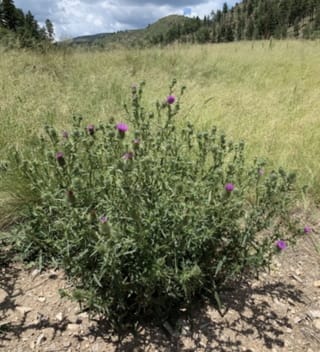 Photo: CK Kelley 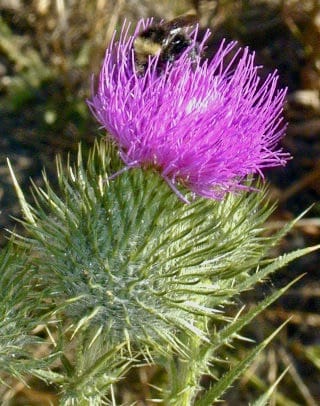 Photo: Akkana Peck 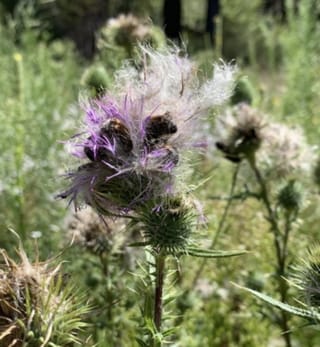 Photo: Jim Norton |  Bull Thistle, Spear Thistle, Common ThistleCIVU (Cirsium vulgare)Family: Asteraceae (Dasies) Size: 40 - 68 in (102 - 173 cm) Growth: forb/herb; biennial Status: non-native; classified weed (common) Native Range: Europe, western Asia, and northwestern Africa NM Noxious Weed Class: B - limited distribution Habitat: colonizes bare, disturbed ground, and persists in heavily grazed grasslands Control Notes: best way to clear is by deep cutting the taproot before the seeds mature; use a post-emergence herbicide when it is in the rosette to flower stage Bull Thistle and the very similar Canada Thistle (C. arvense) are easily confused with native New Mexico Thistle (C. neomexicanum) which does not spread aggressively. The trick is to look for prickles on the stems. Invasive thistles have spiny stems while native New Mexico Thistle does not. The plant blooms from June through October. The flowers are dark pink to purple with spiney bracts and elongated stems. The flowers have a large amount of nectar for pollinators. The seeds are dispersed by the wind and eaten by many small birds. However, while sheep and goats will gaze on Bull Thistle, cattle will not eat it. The plant is only spread by seed which can persist in the soil for up to 4 years. Info Photos Distribution |
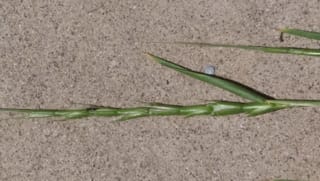 Photo: heynec 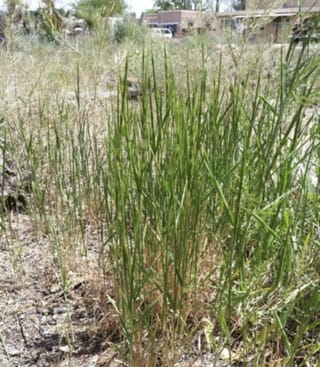 Photo: heynec 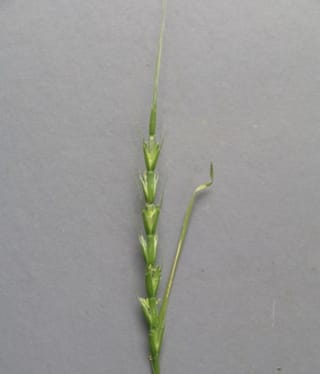 Photo: Barbara L. Wilson |  Jointed Goatgrass, JointgrassAECY (Aegilops cylindrica)Family: Poaceae (True grasses) Size: 6 - 20 in (15 - 51 cm) Growth: graminoid; annual Status: non-native; classified weed (common) Native Range: southern Europe NM Noxious Weed Class: C - widespread Habitat: disturbed soil, along roadways, and field edges Control Notes: use multiple strategies (tilling and mowing, prescribed fire, and herbicides) to eliminate live plants and prevent seed formation including checking seed stock for the presence of weeds Jointed Goatgrass was introduced into North America at several different times and locations. It was most likely brought in with contaminated winter wheat during the late 1800s. Currently about 2 million hectares are infected in the US with an annual increase of 20,000 hectares per year. It is primarily spread by human activity such as planting contaminated wheat, transporting contaminated machinery to different fields, and using particular types of farm machinery that result in greater spread of the seeds as well as creating soil conditions favored by Jointed Goatgrass. Jointed Goatgrass and winter wheat are genetically linked and potentially able to cross-breed. The shape and size of their seeds are similar making it very difficult to clean up grain supplies. The two plants even germinate at the same time and grow at the same rate. Both produce erect flowering stalks with spikelets containing seeds. When mature the Jointed Goatgrass spikelets break into individual segments and can be mistaken for winter wheat straw. As unexpected as it might seem, Jointed Goatgrass has been used with winter wheat to improve its tolerance to a variety of stresses, including diseases and insects. Also cattle in some areas are able to graze on it; while it can be ground into feed for other animals. Info Photos Distribution |
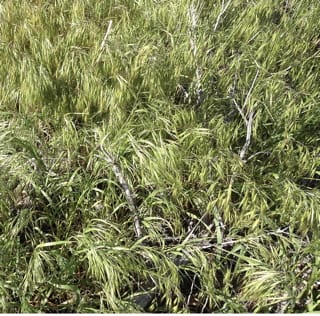 Photo: Famartin 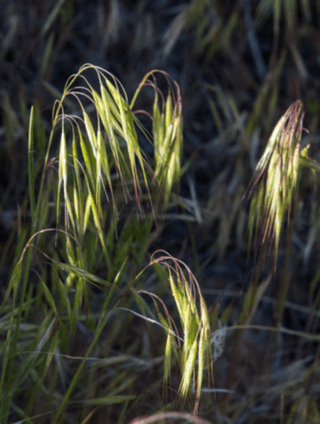 Photo: Neil Gilham 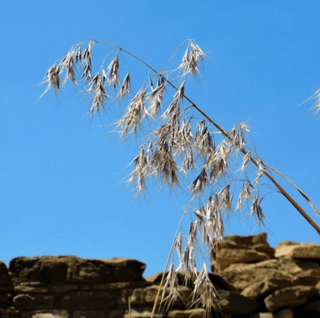 Photo: pahrkrm |  Cheatgrass, Drooping Brome, Cheat GrassBRTE (Bromus tectorum)Family: Poaceae (True grasses) Size: 6 - 24 in (15 - 61 cm) Growth: graminoid; annual Status: non-native; classified weed (common) Native Range: Europe, southwestern Asia, and northern Africa NM Noxious Weed Class: C - widespread Habitat: grows well in coarse-textured soils as well as eroded areas and areas low in nitrogen; pinon-juniper and scrubland Control Notes: mowing within a week of flowering will reduce seed dispersal; burning before seed dispersal will kill the seeds but leaves the site vulnerable to re-infestation; variety of herbicides effective Cheatgrass is a winter annual with smooth stems and hairy leaves. The flowers of this plant are arranged on multi-branched spikes with bristles. The flowers do not open and are self-pollinating. Cheatgrass is most recognizable by it droopy seed heads, leading to the common name of Drooping Brome. The plant often enters a site through disturbed ground, and then quickly expands into surrounding areas through its rapid growth and prolific seed production. The seeds ripen in late spring to early summer and are dispersed by wind, small rodents, and as a contaminant in hay and other grain. Many kinds of livestock as well as deer, small mammals, and game birds will feed on Cheatgrass. Info Photos Distribution |
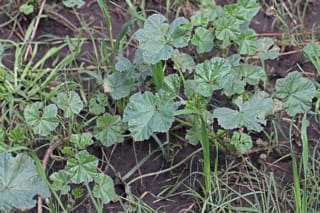 Photo: Jerry Oldenettel  Photo: Jerry Oldenettel 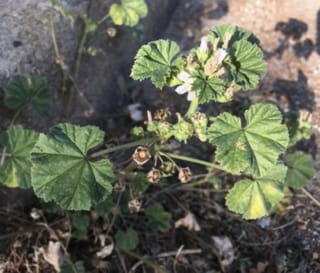 Photo: Ashley M Bradford |  Common Mallow, Cheeseweed, Cheeseplant, ButtonweedMANE (Malva neglecta)Family: Malvaceae (Mallows) Size: up to 24 in (61 cm) Growth: forb/herb; annual, perennial Status: non-native; classified weed (common) Native Range: Eurasia NM Noxious Weed Class: not classified Habitat: disturbed soil in cropland, abandoned fields, farm lots, vacant lots, areas along roads, edges of yards, and gardens Control Notes: hand pull small areas before the seeds form; mature plants very resistant to most herbicides so the best way to control is cover area with healthy plants The Common Mallow is one of several species of mallow introduced into North America from Europe that have become naturalized throughout most of the the US and Canada. The deep taproot of these plants makes them particularly difficult to get rid of and has earned them the classification of “invasive” in numerous areas, particular in the eastern portion of the US. The Common Mallow has rounded fuzzy gray-green leaves and showy light pink or purple blossoms with a notch at the tip of each petal. The seeds of this plant have a very thick coat which allows them to survive in the soil for long periods of time. The plant has been called Cheeseweed due to the facts that the seed pod is round and flat with divisions like a wheel of cheese. Common Mallow is in the Malvaceae family which includes plants such as cotton, hibiscus, and okra. All parts of the plant are edible: leaves and flowers can be eaten in a salad and dried leaves can made into a tea. Info Photos Distribution |
 Photo: Shelly Dawn 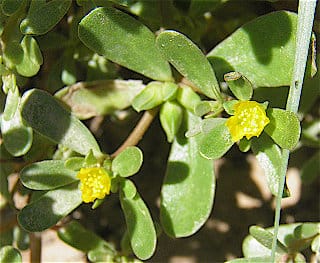 Photo: Terry Foxx 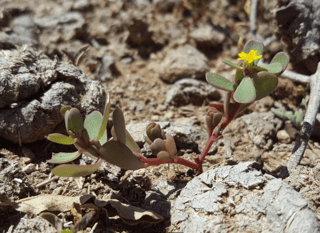 Photo: Alex Abair |  Common Purslane, Verdolagas, Little Hogweed, Red Root, PigweedPOOL (Portulaca oleracea)Family: Portulacaceae (Purslane) Size: up to 16 in (41 cm) Growth: forb/herb; annual Status: uncertain; classified weed (common) Native Range: Africa, Europe, Middle East, India, Australasia, and North America? NM Noxious Weed Class: B - limited distribution Habitat: highly disturbed soil; rocky bluffs, cropland, gardens, barnyards, cracks in city sidewalks, and pavement Control Notes: aggressive treatment is not necessary as disturbed areas will eventually be restored with native ground cover; a post-emergence broadleaf herbicide when the plant is a seedling works The status of Common Purslane with respect to being native or non-native is uncertain. While the plant can be found in growing in many parts of the world, there is no record of its introduction into North America. In contrast, there is some evidence that it was in the continent since at least pre-Columbian times when Native Americans who ate the plant may have spread its seeds. Common Purslane has smooth, reddish stems and leaves that are clustered at stem joints and ends. The flowers are solitary and yellow in color. The plant spreads by seeds and by stem fragments. The stems branch out from a central point, forming a mat up to 1 ft (0.3 m) across. Multiple, close-packed plants can form a dense ground cover. The plant is not considered invasive in the local area but it can outcompete native plants. There are cultivated forms of Purslane that are grown for the fleshy stems and leaves. It can be used raw in a salad or cooked in a soup or stew. The leaves are often sold in farmers’ markets. Small mammals will eat the seeds while herbivores will forage on the foliage. Info Photos Distribution |
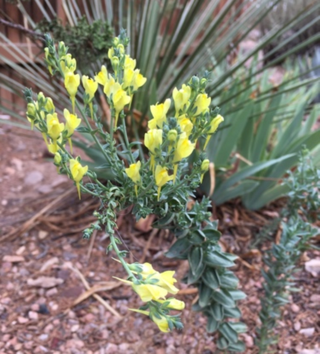 Photo: sweetkindpubliclibrary 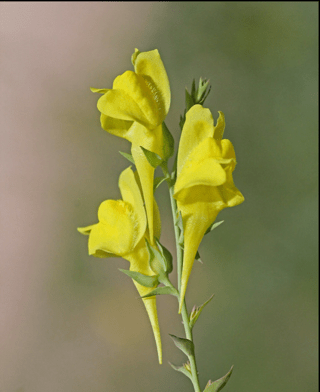 Photo: Jerry Oldenettel 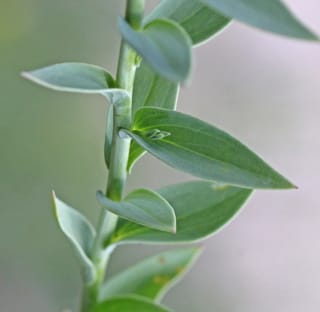 Photo: Jerry Oldenettel |  Dalmatian Toadflax, Balkan Toadflax, Broadleaf ToadflaxLIDA (Linaria dalmatica)Family: Scrophulariaceae (Figworts) Size: up to 36 in (91 cm) Growth: forb/herb; perennial Status: non-native; classified weed (common) Native Range: Mediterranean area NM Noxious Weed Class: A - very limited distribution Habitat: fields, overgrazed pastures, rangeland, waste areas, and along roadsides Control Notes: pull up small infestations, however, the roots tend to beak off and new shoots will re-sprout; fire and mowing are not effective; some herbicides can be used; best thing is to maintain a healthy native plant community Dalmatian Toadflax was introduced into North America in the lat 1800s as an ornamental flowering plant. Since then, it has escaped the garden and spread to the majority of US states and most of the Canadian provinces. It is responsible for significantly reducing livestock production on affected land by crowding out valuable forage. It has no value as food and may actually be harmful to livestock, though most animals avoid it. The overall form of the Dalmatian Toadflax is narrow and upright with multiple stems growing from a single woody base. The leaves are blue-green and egg- or heart-shaped. Bright yellow flowers grow on a spike on the upper stems. The flowers are five-lobed with a bit of orange or white fuzzy beard. The plant has fast-growing lateral roots that can extend up to 10 ft (3 m) or more. A mature plant may produced up to 500,000 seeds. Dalmatian Toadflax is a cousin to the Common Toadflax which is shorter with smaller flowers and narrow, linear leaves. Like the Common Toadflax, the Dalmatian Toadflax has been used as a fabric dye and in a tea for medicinal purposes. Info Photos Distribution |
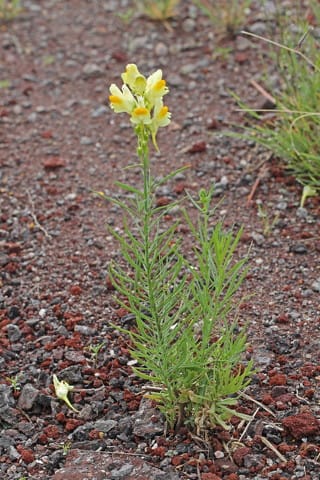 Photo: Jerry Oldenettel 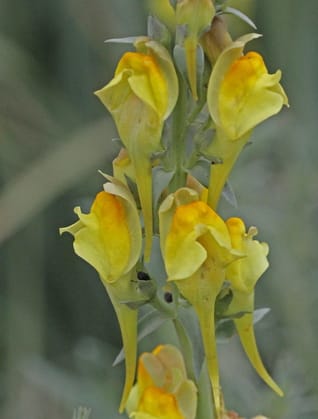 Photo: Jerry Oldenettel 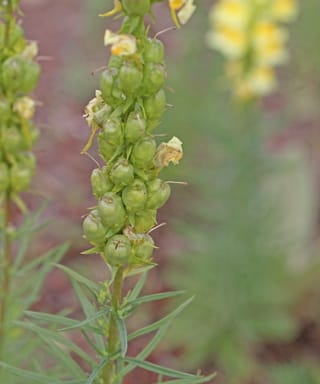 Photo: Jerry Oldenettel |  Common Toadflax, Yellow Toadflax, Butter and Eggs, Jacob’s Ladder, Wild SnapdragonLIVU2 (Linaria vulgaris )Family: Scrophulariaceae (Figworts) Size: up to 24 in (61 cm) Growth: forb/herb; perennial Status: non-native; classified weed (common) Native Range: Eurasia NM Noxious Weed Class: A - very limited distribution Habitat: roadsides, edges of fields, rangelands, meadows, cultivated fields, and wastelands Control Notes: digging up infested areas several times during a season beginning in spring eliminates most of the plant; seeding with well adapted grasses can outcompete the plant; also certain insects that can be introduced that will feed on the plant. Common Toadflax was brought to North America by immigrants that cultivated for use as a yellow dye. It is thought to have escape to the wild in the mid-1800’s. The plant can reproduce by seed and creeping roots; thereby often forming colonies. Common Toadflax has very narrow, hairless leaves with pointed tips on relatively unbranched stems. It produces yellow flowers with orange throats and a spur-like appendage at the base. Seeds are dark in color, flattened, and have a papery wing. They can remain viable for up to 10 years in the soil. The plant is similar in appearance to the Dalmatian Toadflax. The latter has more heart-shaped leaves, slightly larger flowers, and is taller overall. Common Toadflax has diuretic and fever-reducing properties. A tea made from the leaves is drunk to treat a wide variety of diseases. In addition, the leaves have been made into an ointment for the skin diseases. It should be noted that the plant may be mildly toxic to livestock. Info Photos Distribution |
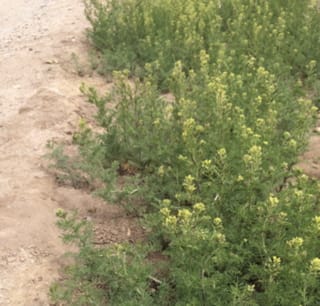 Photo: Karen Herzenberg 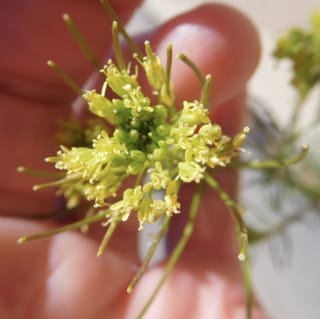 Photo: Ellen Hildebrandt  Photo: Ellen Hildebrandt |  Herb Sophia, Fluxweed, Flixweed TansymustardDESO2 (Descurainia sophia)Family: Brassicaceae (Mustards) Size: 10 - 30 in (25 - 76 cm) Growth: forb/herb; annual, biennial Status: non-native; classified weed (common) Native Range: Europe and northern Africa NM Noxious Weed Class: C - widespread Habitat: disturbed sites, washes, roadsides, railroad rights-of-way, and old fields Control Notes: maintaining a healthy plant community in favor of late successional plants is the best way to prevent its establishment; if necessary, mechanical removal or herbicides are effective Herb Sophia is a late successional plant that invades rangelands disturbed by heavy grazing. It is also a common invasive plant during restoration projects. It is considered a crop pest as it potentially contributes to the transmission of some plant viruses. Large quantities of the plant are toxic to livestock, causing blindness and staggering. Along the same lines, most wildlife do not appear to consume Sophia Herb, but rather favor other tansy mustards, though it is a favored food for some butterfly larva. Herb Sophia is one of the first plants to appear in spring. A rosette of basal leaves form first, from which sprout a stem and additional leaves. Flowers appear at the tips of branching stems as flat clusters. Multiple seeds form in inch long pods. In German, the plant is call Sophienkraut in honor of Saint Sophia who protects against late frost. In India, the stems and leaves are used as a fiber. In Iran, the seeds are used to favor a cold drink during the summer. The seeds have also been used as a spice, similar to pepper. Lastly, Herb Sophia has been used medicinally to treat dysentery as well as a variety of other used. Info Photos Distribution |
 Photo: Craig Martin  Photo: Jerry Oldenettel  Photo: hikingsandiego |  Hoary Cress, Globed-podded Hoarycress, Heart-podded Hoarycress, Whitlow Grass, WhitetopCADR (Lepidium draba, Cardaria draba)Family: Brassicaceae (Mustards) Size: up to 24 in (61 cm) Growth: forb/herb; perennial Status: non-native; classified weed (common) Native Range: southeastern Europe and western Asia NM Noxious Weed Class: A - very limited distribution Habitat: grainfields, hayfields, and on roadsides Control Notes: pull or mow removing roots, if possible, and monitored for regrowth from root fragments; mowing can reduce seed production and better enable targeting of herbicides; plowing once a month for several years will eliminate the plant Hoary Cress was most likely introduced into North America in contaminated shipments of alfalfa. It was found first in California in 1876. It is an aggressive plant crowding out native species and reducing crop yields. A single plant can grow to cover an area up to 12 ft (3.7 m) in its first year. It can then spread at a rate of up to 5 ft (1.5 m) per year. Its roots may go down as far as 15 ft (4.5 m). Hoary Cress stems are branched and covered with light-colored soft hairs. The leaves are mostly toothed. The flower heads are slightly domed clusters with individual white, clawed flowers . The many, small flowers give the plant its white-topped appearance. Lepidium draba seed pods are heart-shaped and thus differ from the other whitetop species. The plant reproduces both by seeds and rhizomes. The leaves of Hoary Cress can be eaten early in the spring. They have a spicy mustard flavor. However, as the plant matures, the taste become bitter and unpalatable while the nutritional value to livestock decreases. Info Photos Distribution |
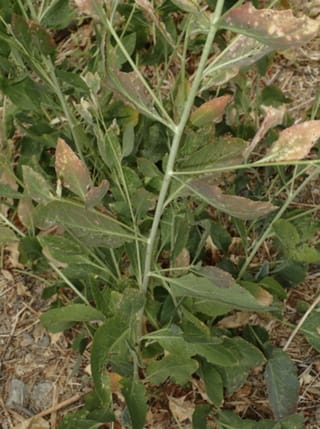 Photo: yetikat 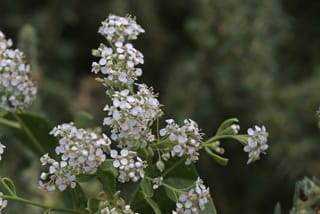 Photo: Andy Zharkikh 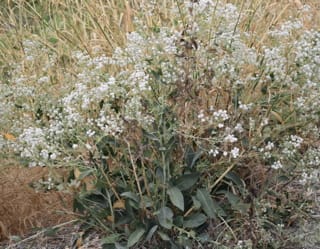 Photo: Anne Parsons |  Broadleaved Pepperweed, Perennial Pepperweed, Peppergrass, Tall WhitetopLELA2 (Lepidium latifolium)Family: Brassicaceae (Mustards) Size: 36 - 48 in (91 - 122 cm) Growth: forb/herb; perennial Status: non-native; classified weed (common) Native Range: southern Europe, northern parts of Africa, and southwestern Asia NM Noxious Weed Class: A - very limited distribution Habitat: most invasive in wetlands, but from there can spread to the riparian zone, and further to rangelands roadsides Control Notes: seedlings can be pulled up but not a long term control method; burning not effective; mowing followed by herbicide has been an effective Broadleaved Pepperweed was accidentally introduced into the United States around 1936 as a contaminant in seed. It has spread rapidly and can form dense monocultures that crowd out native species. The plant has numerous woody stems and waxy leaves with clusters of small, white flowers and small, two-seeded red fruits. The seeds lack a hard coat, leading to the belief that seed viability may be short. The root network is extensive and can reach as deep as 9 ft (3 m). The dried stems of the plant are sometimes used in floral arrangements. Leaves, shoots, and fruits are edible. The bitter taste of the plant can be removed by boiling the shoots and leaves, and then soaking in water for a few days. Cattle, sheep, and goats will graze on Broadleaved Pepperweed, especially on the rosettes in early spring. Info Photos Distribution |
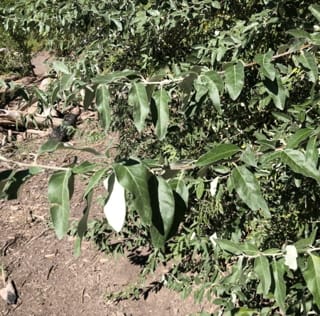 Photo: datkin 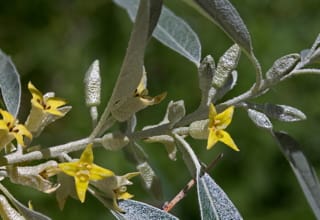 Photo: Craig Martin 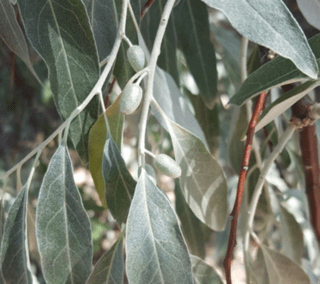 Photo: Alex Abair |  Russian Olive, Russian SilverberryELAN (Elaeagnus angustifolia)Family: Elaeagnaceae (Oleasters) Size: 180 - 276 in (457 - 701 cm) Growth: shrub, tree; perennial Status: non-native; classified weed (common) Native Range: Eurasia NM Noxious Weed Class: C - widespread Habitat: canyon, disturbed soil, grassland, riparian, and scrubland Control Notes: mow saplings; use cut stump method for mature trees — cut as low as possible, apply high-strength vinegar or herbicide The Russian Olive was imported into North America by the late 19th century. It is a fast-growing, resilient and drought-tolerant plant that could bed used to prevent erosion and provide wind-resistant hedges. Unfortunately, these same properties, lead to uncontrolled spreading and overcrowding of native vegetation. The plant is now listed on noxious weed lists in many parts of the US and Canada. In fact, in some areas, it is even mandatory to cut down and remove existing plants. Elaeagnus angustifolia is similar in appearance to a true olive Olea europaea but not related. It looks like a thorny shrub or small tree. Stems, buds and leaves have a dense covering of silvery-to-rusty scales. Young branches are whitish, while the older branches are brown-to-black and tend to have thorns. Leaves are oblong with silver scales on both sides. Flowers are fragrant with silver on the outside and yellow within. There are usually one to three flowers grouped together. Each oblong fruit which is like a berry contains one seed and is covered by silver scales. Russian Olives are grown in parts of their native range as an ornamental shrub. The flowers attract honey bees and the fruits are eaten by birds and other small animals. The fruits taste sweet but are usually dry and mealy. Lastly, the Russian Olive “olives” have been harvested for their oil since ancient times. Info Photos Distribution Tree Guide |
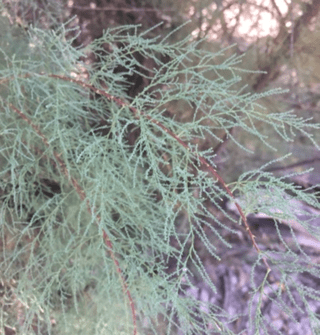 Photo: Gordon Immig/a> 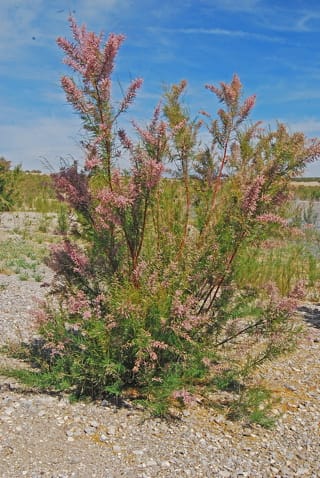 Photo: Jerry Oldenettel 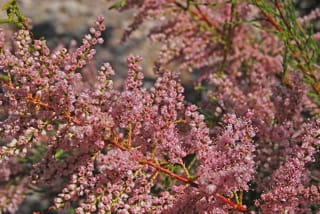 Photo: Jerry Oldenettel |  Saltcedar, Five-Stamen TamariskTARA (Tamarix ramosissima)Family: Tamaricaceae (Tamarisks) Size: 40 - 280 in (102 - 711 cm) Growth: shrub, tree; perennial Status: non-native; classified weed (common) Native Range: Eurasia NM Noxious Weed Class: A - very limited distribution Habitat: riverbanks, stream courses, and irrigation ditches Control Notes: removal by hoeing or digging can be used for small areas; grubbing with a tractor and excavating individual trees effective; some biological controls under study; aerial spraying herbicides tested successfully Tamarix famosissima is grown in its native range as an ornamental. It is very hardy and tolerates poor soils well. It was for these same reasons that Saltcedar was introduced into the US in the 1830’s where it was actively planted as a windbreak and for stream bank stabilization. Unfortunately, the plant spread rapidly, consuming large amounts of groundwater in riparian and wetland habitats and crowding out native species. It is now a noxious weed through the Southwest and drier areas of California. Saltcedar is a shrub or small tree with bark that is reddish when young and turning brown with age. The leaves are gray-green and have an unusual feathery quality. The blooms are quite showy with clusters of pale pink to white five-petaled flowers. The fruit consists of capsules that each contain numerous tiny seeds which are dispersed by the wind. The plant’s common name comes from the fact that it is able to tolerate salt water by excreting salt through special glands in its leaves. It produces salt deposits which both kill other species and cause increased erosion. Livestock will browse on Saltcedar but the plant has little nutritional value and is generally not preferred. Goats, though, can be used to help suppress re-sprouting in areas under control. On the positive side, Saltcedear provides nesting habitats for some birds, including the endangered Southwestern Willow Flycatcher. Info Photos Distribution |
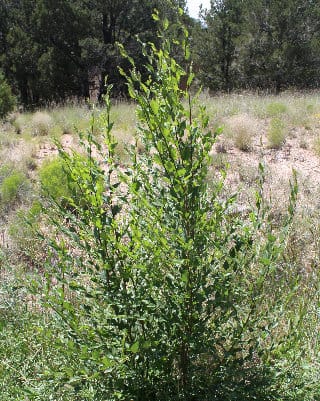 Photo: Akkana Peck 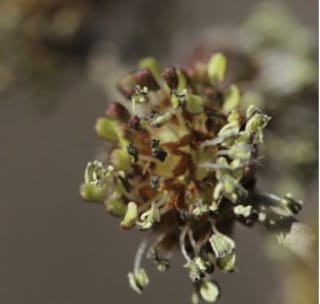 Photo: Nathan Taylor 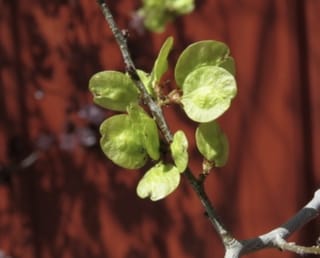 Photo: Brandt Magic |  Siberian ElmULPU (Ulmus pumila)Family: Ulmaceae (Elms) Size: 600 - 840 in (1,524 - 2,134 cm) Growth: shrub, tree; perennial Status: non-native; classified weed (common) Native Range: central Asia NM Noxious Weed Class: C - widespread Habitat: on disturbed ground and abandoned lots, along railroad tracks, near field windbreaks, and close to vacant buildings Control Notes: pull/dig up seedlings and small trees; girdling can be effective for mature trees in late spring to mid-summer, otherwise herbicides are required Ulmus pumila has been widely cultivated both in its native range and in a large number of places world wide for its rapid growth and drought tolerance. It is thought to have been introduced into the US in 1905. The trees were cultivated at the USDA Experimental Station in North Dakota. They flourished there and were subsequently selected by the USDA for planting in the aftermath of the Dustbowl. Unfortunately, the plant is quite invasive in cities and open areas and has been classified as invasive in a large number of states. Fortunately, it rarely invades mature forests. The Siberian Elm is a small to medium-sized tree or a tall bushy shrub. The bark is dry gray and irregularly fissured. Leaves are elliptical and change from dark green to yellow in autumn. The green and brownish-red flowers are rather small. The fruit is flat, round, and paper like. Each fruit or samara contains a single seed. A impressive local example of a Siberian Elm can be seen in Santa Fe at the Palace of the Govenors. The Siberian Elm is of interest to botanists due to its resistance to Dutch elm disease. This has lead to the development of several hybrids between Ulmus pumila and other elm species trying to create a tree with a more native appearance but strong resistance to Dutch elm disease. In addition, as the area is getting drier and hotter, researchers are beginning to think that the Siberian Elm may be value when the native trees starting to die off. Info Photos Distribution Tree Guide |
 Photo: Jen Macke 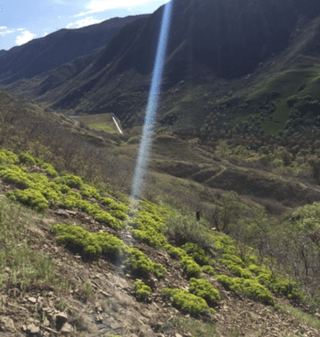 Photo: EP Johnson 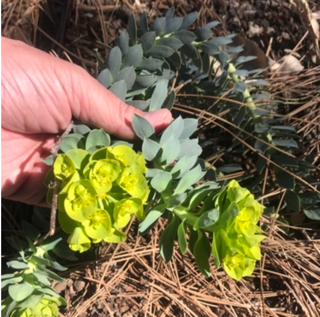 Photo: Jame N. Stuart |  Myrtle Spurge, Donkeytail Spurge, Blue SpurgeEUMY2 (Euphorbia myrsinites)Family: Euphorbiaceae (Spurges) Size: up to 6 in (15 cm) Growth: forb/herb; biennial, perennial Status: non-native; classified weed (common) Native Range: southern Europe and Asia Minor NM Noxious Weed Class: on watch list Habitat: fields, rangelands, gardens, disrupted areas, and roadsides Control Notes: for small areas, plants can be pulled early in the season prior to seed formation (use gloves to avoid the sap); for large areas herbicides may be needed Myrtle Spurge was imported to to be grown as an ornamental plant. It grows extremely well in hot, dry areas. It is an aggressive plant and escaped cultivation into the wild where it is known for crowding out native species. It has been classified as a noxious weed in some regions. For example, it is illegal in Colorado to grow Myrtle Spurge and landowners are required by law to eradicate it. Myrtle Spurge is a short evergreen with a woody base and trailing stems. The blue-green leaves are thick and waxy. with a point at the tip. They are arranged in tight spirals around the stems. The greenish flowers are inconspicuous but surrounded by bright, showy, yellow bracts. The flowers are arranged in clusters. The fruit consists of a bluish-green seed pod containing several long seeds which can be projected up to 15 feet from the plant. Myrtle Spurge has a caustic, milky sap that can cause significant eye and skin irritation including redness, swelling, and blisters. Children and pets are particularly susceptible. Precautions should be taken when handling the plants. Info Photos Distribution |
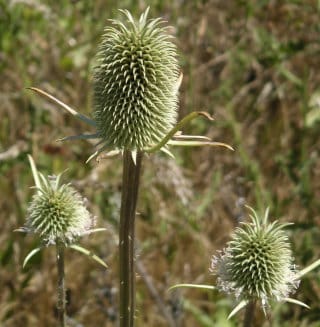 Photo: Akkana Peck 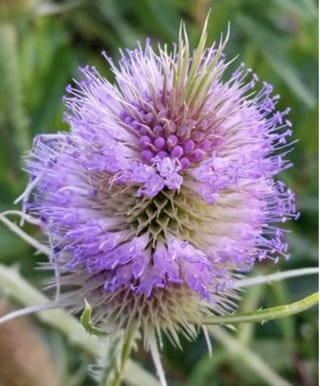 Photo: pobrito 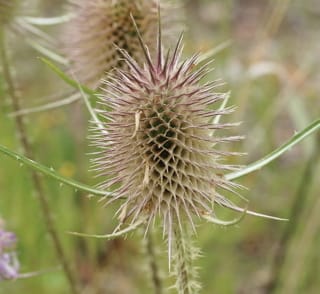 Photo: Craig Martin |  Common Teasel, Fuller's TeaselDIFU2 (Dipsacus fullonum)Family: Dipsacaceae (Teasels) Size: 36 - 72 in (91 - 183 cm) Growth: forb/herb; biennial Status: non-native; classified weed (common) Native Range: Eurasia NM Noxious Weed Class: B - limited distribution Habitat: disturbed soil in open, sunny areas, roadsides, creeks, fields, pastures, and gardens Control Notes: mow flowering stems prior to seed production; dig up the plants when the population is small; plant cover crops will reduce the infestation; use herbicides should be on pre-flowering plants The stem and leaves of the Common Teasel are prickly and the flowers are dark pink or purple and for a head on the end of the stem. The genus name is derived from the word for thirst and refers to the way leaves cup at the stem can hold water. It has been proposed that this deters sap-sucking insects from climbing the stem. Common Teasel was introduced into North American during the 1700s. It was cultivated for use in textile processing as the heads can be used as a comb for processing wool. The seeds are important in winter as food for some birds. Teasel is occasionally grown as an ornamental, while the dried heads are used by florists. When the plant invades an area, it will form a large monoculture, displacing other species. It is not considered to be toxic but has been used for medical purposes. So using it for livestock is not advised. Info Photos Distribution |
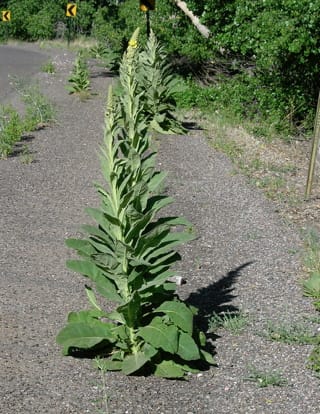 Photo: Jerry Oldenettel 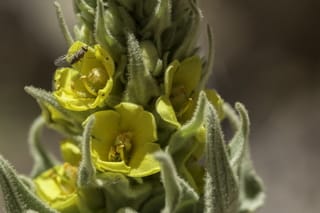 Photo: Craig Martin 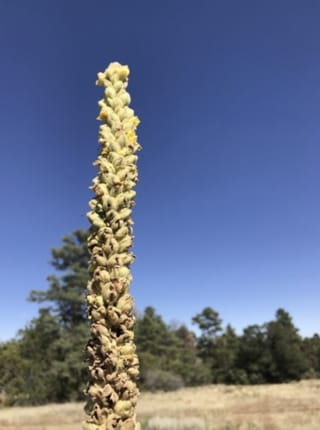 Photo: hendersojn7 |  Common Mullein, Great Mullein, Flannel Plant, Velvet PlantVETH (Verbascum thapsus)Family: Dipsacaceae (Teasels) Size: up to 72 in (183 cm) Growth: forb/herb; biennial Status: non-native; classified weed (common) Native Range: Eurasia NM Noxious Weed Class: C - widespread Habitat: well-lit, disturbed soils in sides of banks, meadows, roadsides, forest clearings, and pastures Control Notes: hand pull and hoe following by planting native plants; plant resistant to contact herbicides due to its hairy nature; burning is ineffective Common Mullein was first introduced into the United States in the mid-1700s by Virginia colonists and used to poison fish as the leaves and seeds of the plant contain a natural pesticide. In addition, the flowers have been used as a hair dye; while the leaves were made into candle wicks or put into shoes to insulate them. Common Mullein is not eaten by grazing animals due to the plant’s many tiny hairs irritating hairs. During the first year of its growth, Common Mullein forms a large basal rosette with fuzzy leaves. In the second year, it produces a large, erect, wooly stalk that can grow up to 8 ft (2.5 m) tall with yellow flowers. The flowers have a honey-like scent that arrests pollinators. After flowering the plant usually dies, leaving a very large number of minute seeds that are scattered by the winds. Info Photos Distribution |
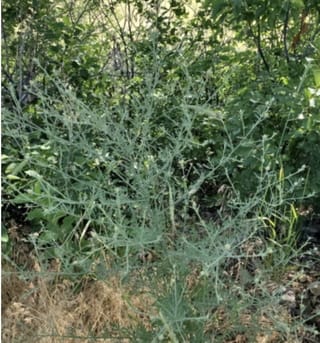 Photo: Sean Avery 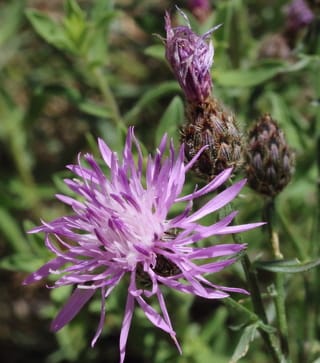 Photo: Craig Martin 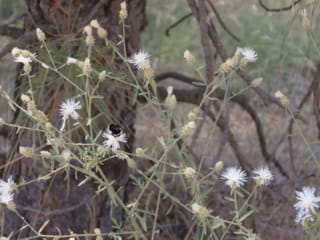 Photo: Barbara L. Wilson |  Diffuse Knapweed, White KnapweedCEDI3 (Centaurea diffusa)Family: Convolvulaceae (Bindweeds) Size: 8 - 40 in (20 - 102 cm) Growth: forb/herb; annual, perennial Status: non-native; classified weed (common) Native Range: eastern Mediterranean NM Noxious Weed Class: A - very limited distribution Habitat: disturbed areas in fallow land, ditches, rangelands, and roadsides Control Notes: cut, dig, or burn; certain insect species can control knapweed; some herbicides, often in combination, may help Diffuse Knapweed was first identified in the North America in 1907 in an alfalfa field in Washington state. Presumably the seeds were transported in an impure seed shipment. The plant has spread rapidly throughout much of the western United States and Canada. It has been reported that it is increasing its range at a rate of 18% annually. Diffuse Knapweed invasiveness decreases plant diversity and wildlife habitat while increasing soil erosion rates. The plant has little value as forage as its thistles can damage the mouth and digestive tract of animals, both wild and domestic, trying to feed on it. The plant consists of a highly branched stem with a large taproot and a basal rosette of leaves. Both the stems and leaves are covered in short, dense hairs. White or pink flowers grow out of urn-shaped heads located at the tips of many branches. Seeds are dark brown and small without a bristle structure. A single flower can produce 1,200 seed. It should also be noted that if a plant is broken off at the base, it will act like a tumbleweed dispersing its seed as it is blown around. Info Photos Distribution |
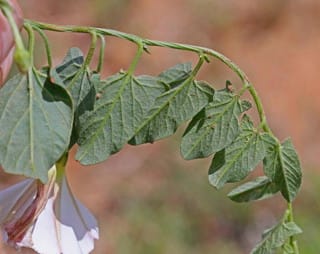 Photo: Jerry Oldenettel 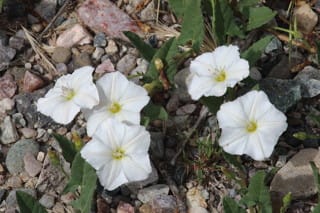 Photo: Craig Martin 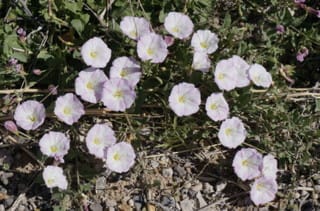 Photo: Ilja Fescenko |  Field Bindweed, Creeping Jenny, European Bindweed, Smallflowered Morning GloryCOAR4 (Convolvulus arvensis)Family: Convolvulaceae (Bindweeds) Size: 1 - 2 in (3 - 5 cm) Growth: forb/herb; perennial Status: non-native; classified weed (common) Native Range: Eurasia NM Noxious Weed Class: C - widespread Habitat: cultivated fields, pastures, gardens, lawns, and roadsides Control Notes: a combination of techniques is necessary to control the plant; pull up when young and roots are still small; dig deep enough to get all of the root of older plants; frequent tilling at the bloom stage is helpful; patches can be treated with herbicide in mid-summer before they seed; bindweed gall mite or the bindweed moth can be released Field Bindweed, despite its pretty flower, is New Mexico’s worst weed. It is very difficult to eradicate once it is established. Seeds can sprout after remaining dormant in the soil for as long as 20 years. Due to the plant’s extensive root system, it outcompetes crops for moisture and nutrients leading to reduced yields. Field Bindweed is a vine with stems that run along the ground or climb up any available object. The stems can be up to 6 ft (2 m) long and will form dense, tangled mats. The leaves of the Field Bindweed are lobed at the base and generally arrowhead-shaped. The flowers consist of five fused petals that for a trumpet-like tube. They are white or purplish-pink in color. An individual flower is only open for a single day. The seeds are very small and pear-shaped. The seeds hard coat allows it to remain viable in the stomachs of migrating animals up to 5 days, resulting in long range dispersal. Info Photos Distribution |
